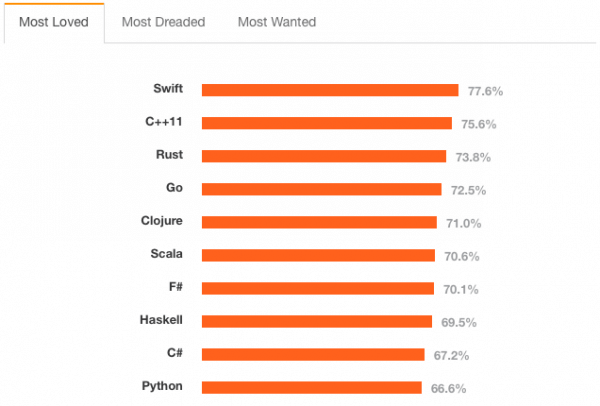Download our E-BOOK
5 Reasons to Learn to Code in Swift
June 17, 2015
by Ashley Rondeau
Earlier this month, Apple announced Swift 2, an updated version of the app programming language that Cupertino has been pushing for over a year now (to give a sense of how hard Apple is pushing it, at WWDC all the sessions were done in Swift). The new update comes with a slew of new features, and it prompted us to explore the many reasons more and more app developers need to learn how to code in Swift if they want to continue to be relevant in iOS. Here are the top 5 reasons to learn to code in Swift.
1. It’s going open source. And everywhere.
Second, app developers love this move because they’ll be able to really dig into the Swift language and play around with it. The real power of Android was unleashed when talented programmers molded it to fit their own needs, and that’s what will happen with Swift as well. Of course, being open source, it allows developers to port the language to other platforms; even Windows and Android. We’re going to be seeing Swift everywhere soon, so now is a great time to learn the language.
2. It’s easy to learn, especially for beginners.
Raphael Miller, mobile app developers for Getty Images, said “we’ve noticed that with Swift you can bring in junior people quicker…. The learning curve is still there, but it seems like people pick it up faster, and they’re less worried about syntax and more about just writing code.” Because of this lower barrier to entry, we’ll be seeing more young programmers cut their teeth on Swift in the future.
3. It’s less prone to bugs and breaking.
One example of Swift’s advantage over Objective-C: coders don’t have to declare the type of variable if they are assigning values to it. Swift will “infer” the type, which is something ObjC doesn’t do. Thus, there are less places for mistyped code. Smart features like this, along with the huge benefit of seeing real-time changes in this “live coding” language, and it’s easy to see why Swift is such a hit.
4. It’s faster than Objective-C.
and here it is, much more succinctly, in Swift:
var favoriteNumbers = [“Jane”: 7, “Bob”: 21, “Sarah”: 99]
5. It’s already growing like crazy.
Here’s a fun little chart from Stack Overflow via Slashgear surveying over 26,000 developers:
 Developers love Swift. Remember, it was only introduced last summer and it is already ranked #22 in language popularity in a study by RedMonk, which is “unprecedented” growth. Big company names like Lyft and SlideShare are already making the switch.
Developers love Swift. Remember, it was only introduced last summer and it is already ranked #22 in language popularity in a study by RedMonk, which is “unprecedented” growth. Big company names like Lyft and SlideShare are already making the switch.
Still, less than 8% of developers currently use Swift. If anything, this tells us that now is the time for app developers to add this language to your repertoire. It’s on fire, but it’s still the wild west. We think first-movers in this field who can establish themselves as Swift developers will have a leg-up as the language matures and more and more people look to develop apps using it. We’re certainly gung-ho about Swift at Rocket Farm Studios, and can’t wait to see how it matures now that it’s open source.
Ready to turn your app idea into a market leader? Partner with Rocket Farm Studios and start your journey from MVP to lasting impact.”
Teams for App Development
We help companies build their
mobile app faster with go to market strategy

Technology and UX Audits

Early Design Sprints

MVP Creation

App Store

Growth Teams
Download Our Free E-Book
Whether you’re launching a new venture or scaling an established product, Rocket Farm Studios is here to turn your vision into reality. Let’s create something extraordinary together. Contact us to learn how we can help you achieve your goals.



